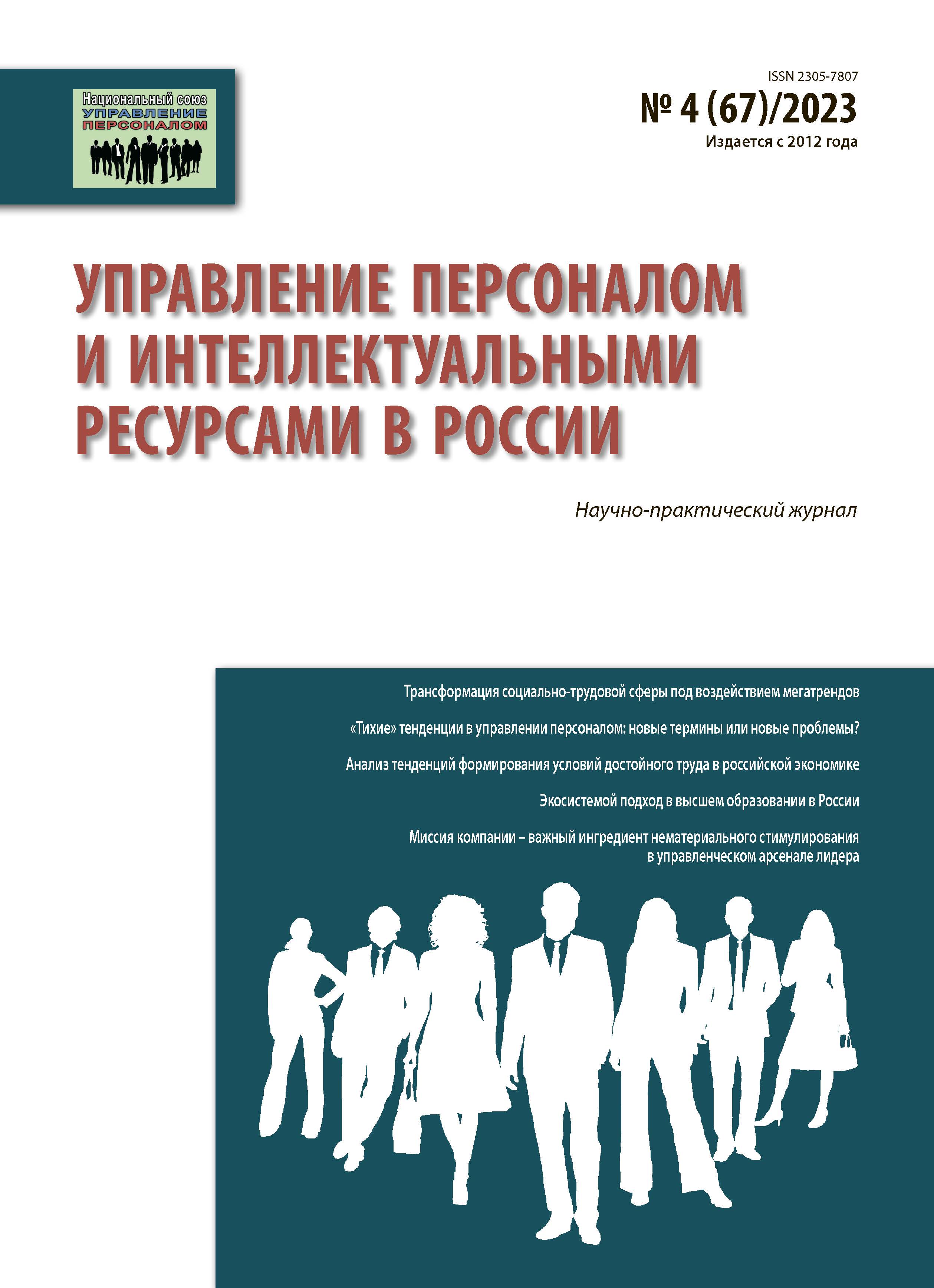Perm, Perm, Russian Federation
In today’s business, the readiness and ability of employees to voluntarily and proactively contribute to the creation and implementation of innovations through continuous improvements in processes, work and other aspects of joint activities becomes an extremely important source of efficiency and development of the organization. This ability is manifested in initiative behavior, the management of which requires the use of methods based on understanding the nature of employees’ proactivity. The article puts forward a theoretical justification for the specific motivational mechanisms of the employee’s initiative behavior, which differ significantly from the mechanisms of normative behavior; in the development of ideas about the intra-motivational nature of proactivity, the process of launching initiative behavior is described, including the stages of creating an impulse-challenge, self-actualization and self-organization; describes the main parameters of the organizational environment that supports staff initiatives. The presented results will be useful for conducting scientific research in the field of proactive behavior, as well as for the development of HR-policy and practical measures to motivate staff.
employee initiative behavior, intrinsic motivation, self-actualization, self-organization, incentive, organizational environment
1. Mitrofanova A.E., Manvelyan H.A. (2021). Motivation and incentives as the main tool for retention of personnel in the organization. Human resources and intellectual resources management in Russia. 2021. Vol. 10 (1). Pp. 24-29. DOIhttps://doi.org/10.12737/2305-7807-2021-10-1-24-29 (in Russian). EDN: https://elibrary.ru/DUVQBB
2. Molodchik A.V. (2009). The concept of a motivational mechanism in a self-development organization. Kadrovik. Vol. 3-5. Pp. 5-11 (in Russian).
3. Orlova L.V., Ivanov I.N., Sundukova G.M. (2022). Knowledge Management as a Resource for Increasing Organizational Creativity. Human resources and intellectual resources management in Russia. 2022. Vol. 11 (1). Pp. 47-50. DOIhttps://doi.org/10.12737/2305-7807-2022-11-1-47-50 (in Russian). EDN: https://elibrary.ru/OPGQHG
4. Esaulova I.A., Semenova I.V. (2017). Management of personnel initiative as the activities of the modern organization. Vestnik Universiteta (State University of Management). Vol. 9. Pp. 26-33 (in Russian). EDN: https://elibrary.ru/ZRWAJV
5. Esaulova I.A. (2020). Company innovative values differentiation in the context of personal mechanisms of employee proactivity and work types. Upravlenets - The Manager. Vol. 11 (2). Pp. 41-52. DOI:https://doi.org/10.29141/2218-5003-2020-11-2-4 (in Russian). DOI:https://doi.org/10.29141/2218-5003-2020-11-2-4. EDN: https://elibrary.ru/MTQOTE
6. Barrick M.R., Mount M.K. (2013). The theory of purposeful work behavior: the role of personality, higher-order goals, and job characteristics. Academy of Management Review. Vol. 38 (1). Pp. 132-53. DOIhttps://doi.org/10.5465/amr.10.0479.
7. Batteman T.S., Grant M. (1999). Proactive Behavior: Meaning, Impact, recommendations. Business Horizons. Vol. 42(3). Rp. 63-70. DOIhttps://doi.org/10.1016/S0007-6813(99)80023-8. DOIhttps://doi.org/10.1016/S0007-6813(99)80023-8.
8. Crant J.M. (2000). Proactive Behavior in Organizations. Journal of Management. Vol. 26 (3). Rp. 435-462. DOIhttps://doi.org/10.1016/S0149-2063(00)00044-1.
9. Evans K. (2012). Employee-driven innovation and workplace learning: Exploring present realities, future possibilities and enduring challenges LLinE. Vol. 4. Available at: http://www.lline.fi/en/article/orientation/karen/employee-driven-innovation-and-workplace-learning-exploring-present-realities-future-possibilities-and-enduring-challenges (Accessed 10.10.2022). DOIhttps://doi.org/10.1177/1024258910364102
10. Gagne M., Deci E.L. (2005). Self-determination theory and work motivation. Journal of Organizational Behavior. Vol. 26. Pp. 331-362. DOIhttps://doi.org/10.1002/job.322.
11. Grant A.M. Ashford S.J. (2008). The dynamics of proactivity at work. Research in Organizational Behavior. Vol. 28. Rp. 3-34. DOIhttps://doi.org/10.1016/j.riob.2008.04.002. EDN: https://elibrary.ru/MFVYYX
12. Grant A.M., Berry J. (2010). The necessity of others is the mother of invention: Intrinsic and prosocial motivations, perspective-taking, and creativity. Academy of Management Journal. Vol. 54, № 1. Rp. 73-96. DOI:https://doi.org/10.5465/AMJ.2011.59215085.
13. Høyrup S. (2012). Employee driven innovation: A new phenomenon, concept and mode of innovation / eds. S. Høyrup, M. Bonnafous-Boucher, C. Hasse, M. Lotz, K. Møller: Employee-driven innovation: A new approach. Palgrave Macmillan. London. Pp. 3-33. DOI:https://doi.org/10.1057/9781137014764_1.
14. Frese M., Fay D. (2001). Personal initiative (PI): An active performance concept for work in the 21st century / eds. B.M. Staw, R.M. Sutton. Research in Organizational Behavior. Amsterdam: Elsevier Science. Vol. 23. Pp. 133-187. DOIhttps://doi.org/10.1016/S0191-3085(01)23005-6.
15. Lockwood N.R. (2007) Leveraging employee engagement for a competitive advantage. SHRM Research Quarterly. Alexandria, VA: SHRM Foundation. Available at: http://www.shrm.org/research/articles/articles/documents/07marresearchquarterly.pdf (Accessed 02.11.2022).
16. Morrison E.W. (2006). Doing the job well: An investigation of pro-social rule breaking. Journal of Management. Vol. 32. Rp. 5-28. DOIhttps://doi.org/10.1177/0149206305277790. EDN: https://elibrary.ru/JNSUXB
17. Parker S.K. (2000). From Passive to Proactive Motivation: The Importance of Flexible Role Orientations and Role Breadth Self-efficacy. Applied Psychology: An International Review. Vol. 49. Pp. 447-469. DOI:https://doi.org/10.1111/1464-0597.00025.
18. Rioux S.M., dan Penner L.A. (2001). The Causes of Organizational Citizenship Behavior: A Motivational Analysis. Journal of Applied Psychology. Vol. 86(6). Rp. 1306-1314. DOIhttps://doi.org/10.1037//0021-9010.86.6.1306.
19. Saks A.M. (2006). Antecedents and consequences of employee engagement. Journal of Managerial Psychology. Vol. 21. № 7. Pp. 600-619. DOI:https://doi.org/10.1108/026839 40610690169.






